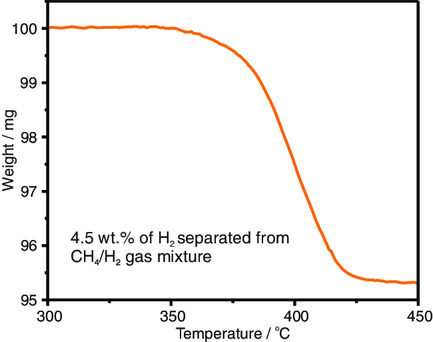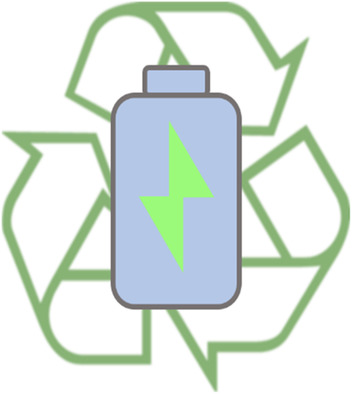Weinheim Symposium on Energy Technology 2021

The inaugural Weinheim Symposium on Energy Technology was held on 17-18 February 2021 to provide an interactive venue for early career researchers in Germany. The topics covered included batteries and electrochemical energy storage, photovoltaics and solar energy, and thermochemical energy conversion and storage and an international audience of almost 500 attendees were treated to the presentations of the latest research from some of the most respected groups in the field. All presenters submitted their articles prior to the symposium, and many of them have been published open access as a result of the agreement between Projekt DEAL and Wiley.
Strategies for Alleviating Electrode Expansion of Graphite Electrodes in Sodium‐Ion Batteries Followed by In Situ Electrochemical Dilatometry
Graphical Abstract
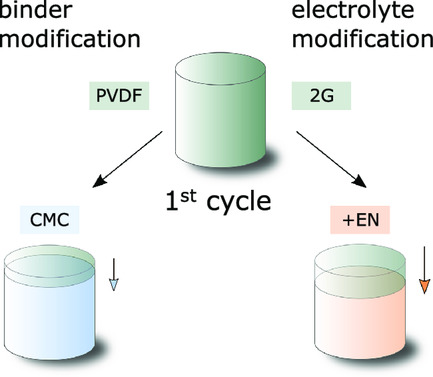
The electrode expansion and shrinkage (“breathing”) of a graphite electrode in a sodium-ion battery is investigated. Changing the binder material from poly(vinylidene difluoride) to the sodium salt of carboxymethyl cellulose results in a smaller electrode breathing in the first cycle but does not influence the following cycles. The addition of ethylenediamine as co-solvent results in reduced breathing in all cycles.
Application of Non‐Precious Bifunctional Catalysts for Metal‐Air Batteries
Graphical Abstract
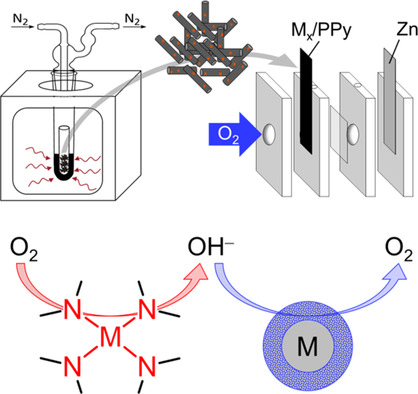
Various bifunctional catalysts for the oxygen electrode are prepared via a fast approach: Polypyrrole nanotubes are impregnated with transition metals and subjected to microwave pyrolysis. In the obtained composite catalysts, MN4 centers perform the oxygen reduction reaction, whereas the oxygen evolution reaction takes place on oxidized metal surfaces. In a zinc-air cell, the prepared catalysts show promising cycling stability.
ZnO‐Based Conversion/Alloying Negative Electrodes for Lithium‐Ion Batteries: Impact of Mixing Intimacy
Graphical Abstract
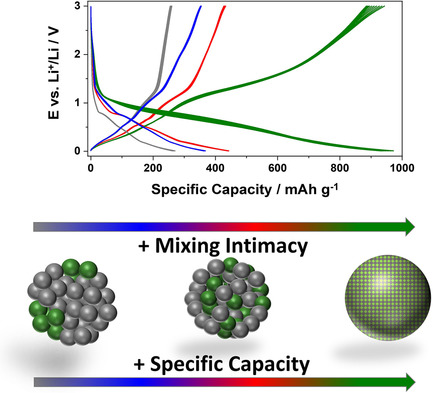
This article compares the impact of introducing cobalt at the atomic level in ZnO (“atomic mixing”) with less and more intimate mixtures of CoO and ZnO nanosized and microsized particles as conversion/alloying anodes for lithium-ion batteries. The findings show that there is a clear trend of an increasing capacity with an increasing intimacy of mixing.
Effect of the Secondary Rutile Phase in Single-Step Synthesized Carbon-Coated Anatase TiO2 Nanoparticles as Lithium-Ion Anode Material
Graphical Abstract

An industrial-scale method is used to synthesize carbon-coated TiO2 nanoparticles, derived in one single step. Depending on the C2H4 sensitizer flow rate and resulting changes in the reaction temperature, more or less of the rutile phase is obtained in addition to the anatase phase. The less of the rutile phase, the higher the reversible capacity and the faster the apparent Li+ diffusion.
Oxygen‐Doped Carbon Nitride Tubes for Highly Stable Lithium–Sulfur Batteries
Graphical Abstract

An oxygen-doped tubular structure carbon nitride is first applied to lithium–sulfur (Li–S) batteries. The high specific area which favors high electrolyte infiltration and the polysulfide intermediates trapping ability, facilitate the transformation of high-order polysulfides to lower-order ones. As a result, oxygen-doped hexagonal tubular carbon nitride (O-TCN)/S delivers a high discharge capacity of 1281 mAh g−1 at 0.05 C.
Solid Electrolyte Interphase Growth on Mg Metal Anode: Case Study of Glyme‐Based Electrolytes
Graphical Abstract
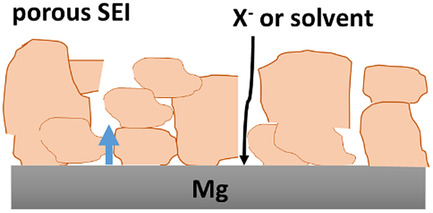
Solid electrolyte interphase (SEI) growth on a Mg metal anode is investigated using electrochemical impedance spectroscopy (EIS) in symmetric Mg cells with model glyme-based electrolytes. EIS indicates composite liquid/solid SEIs where transport occurs predominantly through diffusion in the liquid phase.
Understanding Structure–Property Relationships under Experimental Conditions for the Optimization of Lithium‐Ion Capacitor Anodes based on All‐Carbon‐Composite Materials
Graphical Abstract
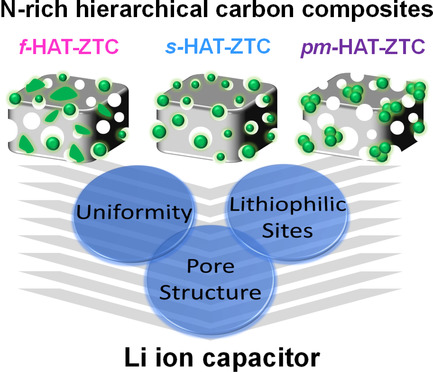
Hierarchical composite materials of electrically conductive and highly porous templated carbon matrices with a nitrogen-rich carbon material are synthesized and characterized as anode model materials for lithium-ion capacitors. Controlling uniformity, content of lithiophilic sites, and pore structure of the composite are the key factors to achieve high and stable capacity. Structure–property relationships are analyzed in detail.
Synthesis and Effective Thermal Conductivity Measurements of Hollow Mesoporous SiO2 Spheres for Heat-Insulating Applications
Graphical Abstract

Herein, a robust synthesis protocol of mesoporous silica hollow spheres in the nanometer scale and their corresponding effective thermal conductivity is shown. All samples exhibit a strongly reduced thermal conductivity at 0.03 mbar of about 9 mW m−1 K−1, which allows them to be considered in vacuum insulation panels.
A Comprehensive Physical‐Based Sensitivity Analysis of the Electrochemical Impedance Response of Lithium‐Ion Batteries
Graphical Abstract
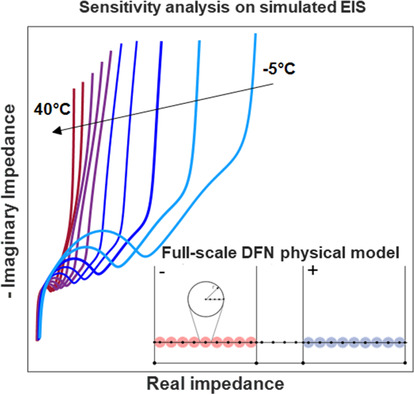
Herein, a physical model for lithium-ion batteries is used to perform a comprehensive sensitivity analysis of the simulated electrochemical impedance spectroscopy; 28 parameters are varied in 20 different operative conditions of battery temperature and state-of-charge, obtaining a deep understanding of the effect of each parameter and the optimal conditions for the model validation with impedance data.
Improved Electrical Performance of Perovskite Photovoltaic Mini-Modules through Controlled PbI2 Formation Using Nanosecond Laser Pulses for P3 Patterning
Graphical Abstract

P3 patterning for serial interconnection of perovskite solar cells by nanosecond (ns) and picosecond laser pulses is investigated. Both pulse durations are suitable, but ns pulses enable an improved current–voltage behavior, due to the formation of PbI2 and a Br-rich interfacial layer, which both effectively passivate defects and block charge carriers in the scribe line vicinity.
Sustainable Solvent‐Free Production and Resulting Performance of Polymer Electrolyte‐Based All‐Solid‐State Battery Electrodes
Graphical Abstract
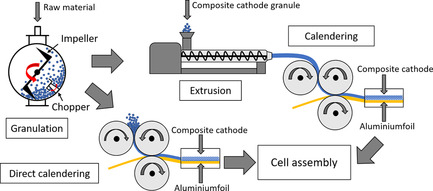
Herein, two scalable and sustainable process chains are presented, which enable an industrial series production, extrusion, and direct calendaring of composite cathode granules. The manufactured pouch cells reach ≈140 mAh g−1 at 0.1C and 75 mAh g−1 at 1C discharge rate and 80 °C, which is comparable to other recent publications on laboratory scale.
Upgrading Waste Heat from 90 to 110 °C: The Potential of Adsorption Heat Transformation
Graphical Abstract

Herein, the potential of adsorption heat transformers (AdHTs) to upgrade abundantly available low-temperature waste heat above 100 °C is estimated. An AdHT with optimized design and control can recover up to 64% of the exergy input and offers competitive power densities. Thus, this model-based study demonstrates the promising performance of AdHTs for exploiting waste heat around 100 °C.
Apples and Apples: A Shortcut Assessment Framework for Early‐Stage Carbon Capture and Utilization Technologies Based on Efficiency, Feasibility, and Risk
Graphical Abstract
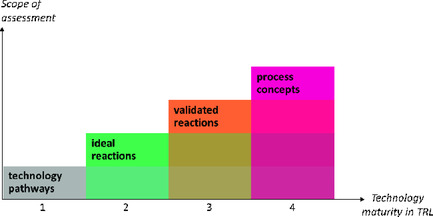
A shortcut assessment framework for early-stage carbon capture and utilization technologies is proposed, based on the perspectives of efficiency, feasibility, and risk (Efferi). The scope of the Efferi framework increases over technology maturity. The Efferi framework implements the Global CO2 Initiative's Guidelines, enables comparisons at different technology maturities, and systematically reduces subjective judgments.
Pyrolysis of Methane and Ethane in a Compression–Expansion Process as a New Concept for Chemical Energy Storage: A Kinetic and Exergetic Investigation
Graphical Abstract

The present work investigates a novel approach for chemical energy storage. The pyrolysis of methane or ethane in a piston engine stores up to 75% of the mechanical energy as chemical energy. The products are chemicals with a high energetic value and industrial use, such as hydrogen, acetylene, ethylene, and benzene.
Standardization as an Instrument to Accelerate the Development of Stable Emerging Photovoltaic Technologies—The IEC TS 62876‐2‐1:2018—Technical Specification for the Stability Testing of Photovoltaic Devices Enabled by Nanomaterials
Graphical Abstract
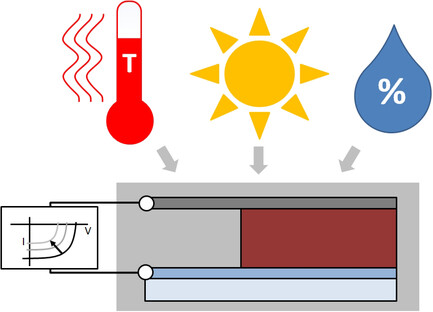
Standardization has a large impact on the development and commercialization of new technologies. Stability is as important as efficiency for the evaluation of the commercial potential of an emerging photovoltaic (PV) technology. Standards for PVs are reviewed with regard to their relevance for technology evaluation. IEC TS 62876 provides standardized procedures for the evaluation of stability.
Disentanglement of Degradation Mechanisms by Analyzing Aging Dynamics of Environmentally Friendly Processed Polymer Solar Cells
Graphical Abstract
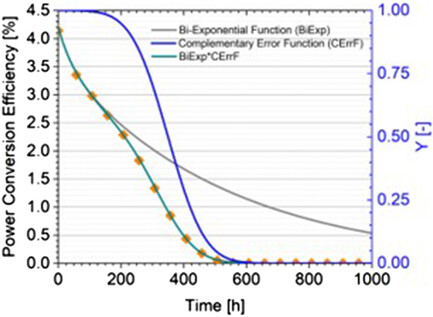
The analysis of aging kinetics reveals the superposition of two individual degradation mechanisms. By modeling the combination of a biexponential decay with a complementary error function, one is assigned to continued intermixing and the other one to the formation of magnesium oxide (MgO), which results in initially higher work functions and a final stage of completely blocking contacts.
Performance and Stability of Organic Solar Cells Bearing Nitrogen Containing Electron Extraction Layers
Graphical Abstract
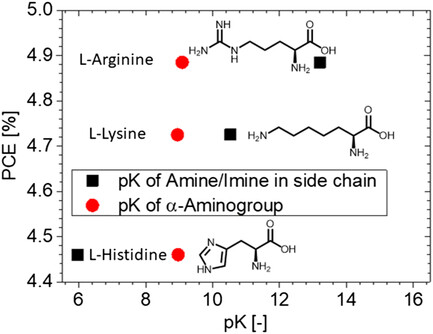
Different amine/imine containing organic compounds are studied as electron extraction layers (EELs) in organic solar cells in regard to performance and stability. In regard to performance there is a strong connection found between content of amine groups and basicity of these groups. The best performing organic EELs work similarly well to the commonly used metal oxide TiOx.




